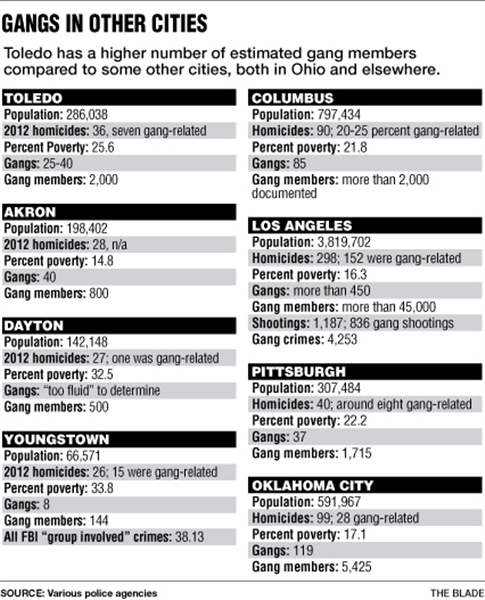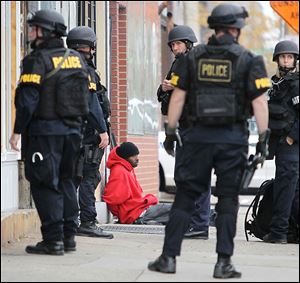
BATTLE LINES: GANGS OF TOLEDO
Toledo’s gangs not very different from others
Causes of feuds same: Everything, nothing
5/1/2013

Cincinnati police detain a suspect after targeting members of the Walnut Hills Posse in 2011. Gang-related homicides dropped 42 percent after the effort.
Last of four parts
SANDUSKY — Enough was enough.
A feud between two rival gangs — the Black Point Mafia and Hancock Kings — led to “a ton of shootings” about two years ago in Sandusky, police Chief John Orzech said.
Last year, numerous gang members were convicted on various charges, including participating in a criminal gang, effectively taking gangs off the police department’s watch list for the first time in more than a decade, the chief said.
Sandusky’s gangs — there were only really a few, the chief said — were not much different than Toledo’s and gangs in other cities around the state.
The National Gang Center reported that, in 2011, an estimated 29,900 gangs existed in the United States, fewer than the 30,800 in 1996.
Many are loosely organized, identifying themselves by streets or neighborhoods.
The Hancock Kings in Sandusky, for example, were named after Hancock Street, an area known for drugs, Chief Orzech said.
Story: Police chief refutes Toledo mayor
Storify: Discuss the series on social media with #toledogangs
Map: Interactive Toledo gang map
About the series:
Battle Lines: The Gangs of Toledo
Videos: Battle Lines: The Gangs of Toledo
Reporter: Taylor Dungjen
Photographer: Amy E. Voigt
Getting the gang story: How 2 Blade staffers overcame obstacles to cover Toledo's gangs
In Lima, police Chief Kevin Martin said Tuesday that gang activity in his area has changed over the last 10 years, becoming less visible and structured than it once was.
Chief Martin said the culture of gangs in the city has shifted from organized groups such as the Bloods or the Crips to groups of friends who might orchestrate the commission of a crime. It makes the gang problem in Lima today, he said, more difficult to define.
“I think it really depends on how you define gangs,” he said. “It’s not really in terms of the way it was a decade or so, but there are groups that gather together.”
The relative calm there today is a far cry from what the city of Lima encountered in the 1990s, according to The Blade archives.
The city police, the Allen County Sheriff’s Office, and even the FBI and the U.S. attorney’s office got involved using targeted sweeps, as well as a national program called Study Circles, in which groups of citizens met to discuss race, crime, and youths, and to curb violence, according to a report published in The Blade on Oct. 30, 2005.
“There were armed home invasions. There were rapes. There were arsons. It was very violent. It was a rough time in Lima,” said Deborah Kovac Rump, a former assistant U.S. attorney, who at the time recalled to The Blade making regular trips from Toledo in the 1990s to work with local, state, and federal law enforcement agencies to prosecute Lima gang members.
Gang members would “come in from Detroit, take over houses and neighborhoods, and sell dope, sell guns, sell women. In Lima, though, the attitude [from police and the community] was never,‘We can’t do it.’ It was always, ‘What do you need?’ ” she said.
The process of decreasing the rampant gang activity took about a decade, and the chief said the department still maintains a focus on the issue.
“Yes, there are gangs in Lima, just like I believe there are almost everywhere,” Chief Martin said. “We're very much aware that it does still exist and that there are still problems like that.”
Akron police reported that gangs in that city take names from geographic areas. It has gangs with names like Johnston Block, Young Street Goonies, and Hill Top, police said. The neighborhood gangs all claim one of the “nations” — Bloods, Crips, or Folk.
Akron police do not track gang-related shootings, but an official said a majority of the city’s shootings are “probably gang-related.”
In 2011, Cincinnati police went after gang members from the Walnut Hills Posse. The Cincinnati Enquirer at the time reported that police indicted 25 people on various crimes. Fifteen were charged with gang-specific crimes.
A Cincinnati police command officer told the newspaper: “This will chop the head off of this [street gang].”
Last year, Cincinnati officials told The Blade gang-related homicides fell 42 percent in the 42 months after implementation of the Community Initiative to Reduce Violence, as compared to the 42 months prior to implementation.
In April, 2012, Toledo adopted the anti-gang and anti-gun violence initiative, and preliminary data suggest gang-related crimes were down in 2012; official data are not yet available.
Police in Dayton and Youngstown said gangs — Youngstown calls them “groups” — have had a presence for decades, like Toledo.
In a survey of police departments that responded to a request for gang information, eight said gang boundaries in their respective cities are fluid.

In Columbus, “the number of sets change weekly because of the nature of gangs in our city,” said Sgt. Richard Weiner, the department’s spokesman. Columbus has more than 2,000 documented gang members and 85 gang sets.
Youngstown, a city with a population of about 66,571, had 26 homicides last year. Sixty percent of those deaths were group or gang-related, police Lt. Jason Simon said.
In 2012, Toledo recorded 36 homicides and seven of them were gang-related, police have said.
The shootings, the deaths, the fights — any of the animosity among gangs — are often about “disrespect.”
Bryce Linebaugh, an 8-year-old from Youngstown’s east side, was sleeping in his upstairs bedroom when he was shot once in the head on Aug. 20.
“It was over something very minor. I remember thinking, ‘Really? You consider that disrespecting?’ He goes to exact his revenge … shoots the wrong apartment, and kills a young child,” Lieutenant Simon said.
Shawn Wilson, 22, of Youngstown pleaded guilty to aggravated murder, improper discharge of a firearm, felonious assault, and tampering with evidence in the boy’s death. He is incarcerated at the Lorain Correctional Institution and serving a life sentence.
Police and gang members in Toledo both said feuds locally can be about everything and nothing. Fights exclusively about colors — red versus blue — are rare, but do happen.
Wrong color, wrong neighborhood.
A man wearing a red hat went to a central Toledo gas station in January to cash a check; when he left, he was jumped by three teenagers waiting for him outside.
Out of earshot, an unrelated individual told the teens, “That’s a slob,” slang meant to be disrespectful toward anyone who associates with a Bloods gang. Toledo police Detective Jeff Quigley recalled the incident during a March hearing for one of the youths at Lucas County Juvenile Court.
The teens are members of the Charge Boyz, a subset of the Crips-affiliated XBlocc gang.
The teenager, 17, was found delinquent of robbery and a gang specification; he was sentenced to serve four years at the Department of Youth Services.
“They wanted to teach him a lesson for wearing red in a Crip neighborhood,” Detective Quigley said.
Contact Taylor Dungjen at: tdungjen@theblade.com, or 419-724-6054, or on Twitter @taylordungjen.